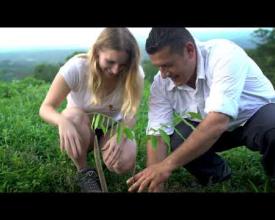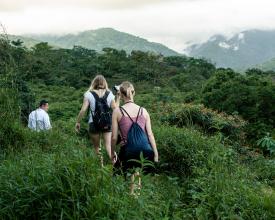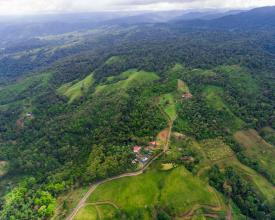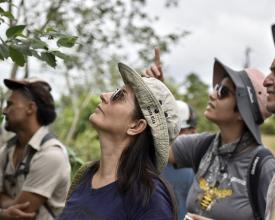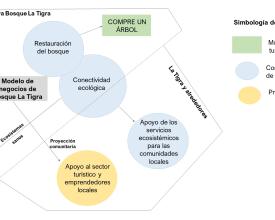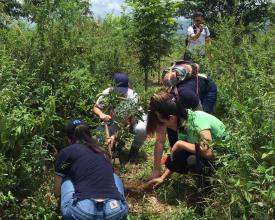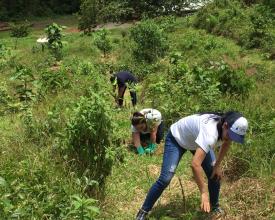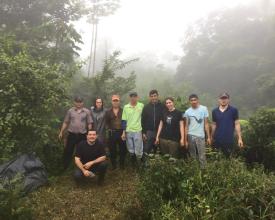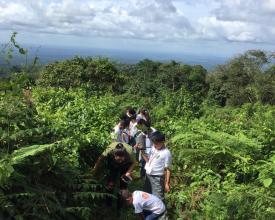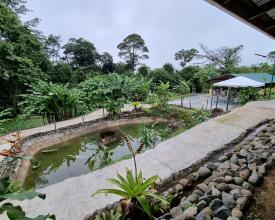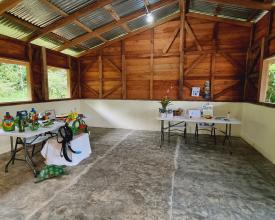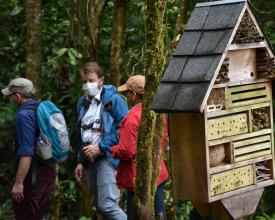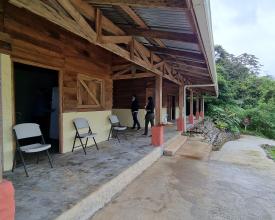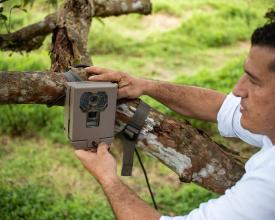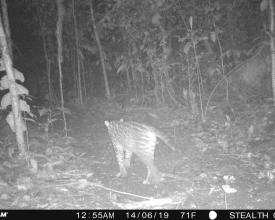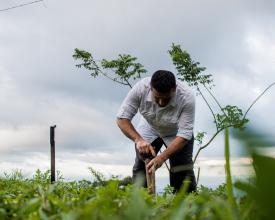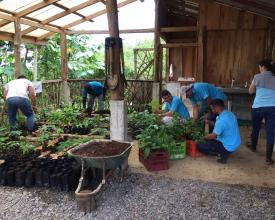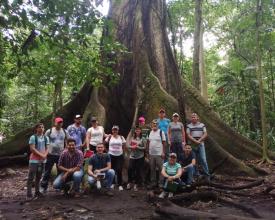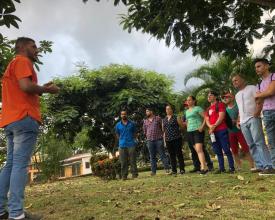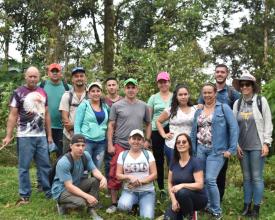
Reserva Bosque La Tigra: A replicable model for sustainable and community based ecotourism
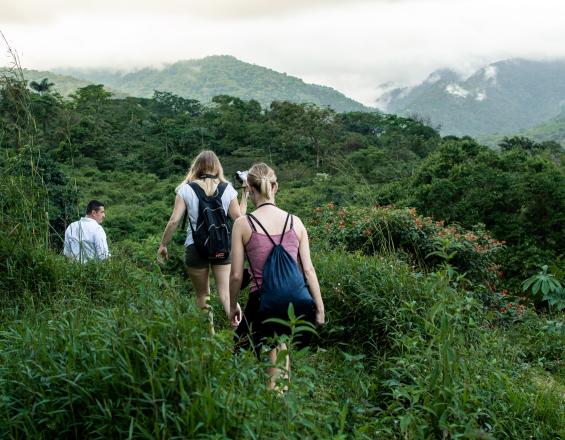
Reserva Bosque La Tigra: Biodiversity in action Costa Rica aims to develop a replicable model for sustainable and community based ecotourism, which includes the creation of the Bosque La Tigra Biological Station-Reserve for the protection and sustainable use of biodiversity, as well as reforestation efforts, carbon fixation, protection of drinking water sources, environmental education, biodiversity monitoring, and development of ecotourism services. Bosque La Tigra also focuses on community outreach, by facilitating capacity building and development of skills in the tourism field for local communities.
The project is an initiative of the Travel to Nature company and the develoPPP program, implemented by the German Cooperation for Development, GIZ, on behalf of the Federal Ministry for Economic Cooperation and Development (BMZ).
Context
Challenges addressed
La Tigra district and surroundings, located in the province of Alajuela, developed an intensive ornamental plant cultivations during the 90s, as its main economic activity which gradually disappeared and left this region with few economic and job opportunities. Moreover, the increase in illegal hunting of species and deforestation has caused significant damage to ecosystems and the local wildlife.
La Tigra and its surroundings are located in the proximity of national and private protected areas. Biodiversity is one of the main attractions of this region, which holds an immense touristic potential that has not been seized.
Bosque La Tigra aims at coming forward as an innovative touristic product that stands out for its high sense of responsibility with local biodiversity. Also, the project aims to reactivate and dynamize the tourist activities in this region, foster the productive chains of touristic services, and creating new opportunities for the local communities of La Tigra and nearby districts.
Location
Process
Summary of the process
Bosque La Tigra through its sustainable business model is committed to carrying out biodiversity responsible business strategies and has engaged to make sustainable use of biodiversity for its touristic offer and to contribute with its conservation, all of these measures to guarantee the continuity of its business in the long run. The building blocks interact from this logic: Bosque La Tigra contributes to the conservation of biodiversity by restoring the forest and improving ecological connectivity. Consequently, healthy ecosystems allow the creation and design of many ecotourism products and environmental education activities that are the basis of Bosque La Tigra's business model. Moreover, the conservation of the forests allows for a healthy flow of ecosystem services that bring benefits to the communities near the project, such as potable water, clean air, climate regulation, and a diverse ecosystem. The comprehensive model is completed by the community outreach scheme that Bosque La Tigra promotes; by delivering benefits to the communities near the Project, which include the development of capacities in the tourism sector, which in turn dynamizes the economy of La Tigra and its surroundings and contributes to local development.
Building Blocks
Forest Restoration and Ecological Connectivity
Bosque La Tigra owns 46 hectares of primary and secondary forests, as well as regeneration areas, as relicts of what used to be passion fruit plantations. Bosque La Tigra adjoins the Children Eternal Rainforest, Costa Rica’s biggest private reserve, with 23.000 hectares. For the Project, this location is a strategic element of the reserve work.
Bosque La Tigra has intended to foster the ecological connectivity of both reserves by conserving the forest and also, by actively restoring the regeneration areas of the reserve with native trees. For this purpose, the project designed a reforestation sequence for the regeneration areas. Eventually, the area will enter into an ecological succession process and foster ecological connectivity with the Children Eternal Rainforest.
At least 40 different species of native trees and bushes have been identified to plant in the regeneration areas. The Project has established a tree nursery that reproduces trees and seedlings from the same primary and secondary forests of the reserve and has a capacity for 700 seedlings and plants.
Between 2017 and 2020, a total of 4500 trees were planted. Every reforestation effort is supported by the voluntary work of students, companies’ employees, national and international tourists, and Bosque La Tigra staff.
Enabling factors
- The presence of primary and secondary forests that harbors native flora, from which seeds can be reproduced, provides genetic material for the reforestation activities of Bosque La Tigra.
- The proximity to a protected area such as the Children Eternal Rainforest favors the movement of local fauna to Bosque La Tigra.
- Private commitment, represented by Travel to Nature, with a business model that relies on regeneration, operates within the boundaries of nature and is designed to work with and support it.
Lesson learned
- The anchoring of forest restoration in Bosque La Tigra's business model is a key element, as the trees are sold to companies, tourists, and visitors, and the income is used to cover the costs associated with the purchase of the property and the acquisition of new properties around the original property. In this sense, companies pay to compensate for their performance through reforestation and carbon fixation and Bosque La Tigra restores the forests as part of its environmental responsibility offer for companies. In this way, international companies sponsor planting lots of up to 500 trees and make them visible as part of their environmental strategies.
Resources
Environmental education: Bosque La Tigra Rainforest School
Bosque La Tigra built a biological station in the reserve that serves as a rainforest school, a place for learning and discovering the forest. Students, tourists families, and visitors can have a first-hand experience at Bosque La Tigra and enjoy the outdoor activities in the reserve.
Families can visit Bosque La Tigra and enjoy a unique experience embedded in the tropical forest. Bosque La Tigra is also a welcoming space for schools and high schools of La Tigra and surroundings, where students can learn about the tropical rainforest, its dynamics, and local biodiversity. The biological station of Bosque La Tigra has classrooms to give lessons for the local communities that are undergoing training in tourist guidance, entrepreneurship, among other topics.
Bosque La Tigra has focused on creating alliances with universities, schools, and learning institutes to cooperate and implement environmental education programs and other training at the biological station. The Project also offers overnight accommodation for students groups to develop outdoor courses and training.
Enabling factors
- Bosque La Tigra has harnessed the benefit of having a unique classroom right outside the biological station: the tropical rainforest. This is an essential feature of the reserve and makes it attractive for visitors and student groups.
Lesson learned
Due to the Covid-19 pandemic, Bosque La Tigra adjusted the overnight accomodations to lodge smaller groups. Initially, they were designed to accomodate large groups, but after the social distancing recomendations this aspect was redesigned. Now, Bosque La Tigra can lodge small groups of students, visitors, families and social bubbles.
Biodiversity responsible touristic offer
Bosque La Tigra developed an attractive tourist product for international and national visitors, communities, and students that aspire to connect with nature and learn from local biodiversity. This tourist product will stand out as an offer that was created with a high sense of environmental responsibility and serves as an example, inspiration, showcase, and replicable model for international and national organizations.
Bosque La Tigra offers guided tours, an interactive walking trail where visitors can learn about the rainforest, local biodiversity, and wildlife. Visitors can enjoy 4 km of trails across primary and secondary forests. The trails are interpreted with signs of the most representative tree species of the forests, with information such as scientific name, common name, and the natural history or a brief description of the species. Visitors can also visit the tree nursery and pick a native tree to plant at the reserve. The reserve also carries out wildlife monitoring activities, installing camera traps that register videos and photographs of the fauna that live at the reserve. Visitors can also see the installation of the cameras and observe videos and photos of local fauna.
Enabling factors
- The proximity of protected forests and the ones it safeguards makes Bosque La Tigra a perfect place to develop a touristic offer that takes advantage of healthy ecosystems and work within its limits, ensuring sustainable use and the conservation of biodiversity.
- Travel to Nature business engagement with sustainable ecotourism and its vision to design a touristic offer that combines exclusive travel experiences with sustainability are key aspects to carry out this kind of business model.
Lesson learned
- Tourism trends worldwide show an increasing need to experience sustainable offers and journeys, in this sense, Bosque La Tigra manages to fulfill the need of this segment and seize the opportunities that these trends offer to ecotourism.
Resources
Community outreach and capacity development for tourism
Bosque La Tigra has a clear vision of community engagement for its business: ecotourism in La Tigra and surroundings can thrive only if all those involved in the tourism sector have the abilities and skills to perform the industry; accordingly the Project identified the needs for training to improve touristic skills for the local communities and entrepreneurs.
- The Project supported the training for 14 persons of the local communities to become official tour guides between 2018 and 2021. They received lessons on Generalities of tourism and tourism ethics, Tourist attention and guidance, Geography and Cultural Tourism of Costa Rica, and Natural history. These future tour guides have accomplished 70% of the curricula.
- The project developed training in Entrepreneurial skills for ecotourist businesses in La Tigra and near districts. In 2021, 15 entrepreneurs received ludic and participatory training to develop their business skills, in topics such as entrepreneur profile, business concept, brand and image, marketing, digital marketing, costs, and business formalization. The training consisted in group sessions and individual mentorship for each participant. The entrepreneurs have increased the visitation to their accommodations and increased the purchases of their products as a result of the training.
Enabling factors
- Bosque La Tigra’s good relationship with local communities has contributed to the easy coordination and follow-up of the activities.
- Local communities are deeply interested and committed to learning and applying new skills to their tourism business.
Lesson learned
- Capacity building and training, especially in the touristic sector, have a great potential to empower people, and in this case entrepreneurs. People have shown great enthusiasm and commitment to the training. Currently, the entrepreneurs apply the acquired knowledge in their touristic products and services with positive results.
Impacts
This comprehensive initiative achieved successful interventions in multiple areas such as tropical forest restoration, enhancing the ecological connectivity, environmental education, capacity building for local communities, and the revitalization and recovery of the touristic sector locally.
Bosque La Tigra accomplished to develop an attractive touristic product for international and national visitors, communities, and students that aspire to connect with nature and learn from local biodiversity. This touristic product serves as an example, inspiration, showcase and replicable model for international and national organizations.
The project was able to implement a business model that operates within the limits of nature and that is designed to work with nature and support it. During the implementation of the project, more than 4000 native trees were planted in the reserve. A total of 46 hectares of secondary and primary rainforest can now thrive and grow under Bosque La Tigra’s stewardship. Water sources that provide drinking water for over 1000 people in La Tigra are now protected.
The project generated impacts far beyond the limits of Bosque La Tigra, currently a group of business owners, entrepreneurs and different stakeholders from La Tigra district and other surrounding districts have engaged in a strategic process to create a new touristic destinations in the region.
Beneficiaries
- Bosque La Tigra surroundings: local communities from San Lorenzo and Peñas Blancas, San Ramón; and La Tigra, San Carlos.
- Schools from La Tigra.
- The local biodiversity of the tropical rainforest of Bosque La Tigra.
Sustainable Development Goals
Story
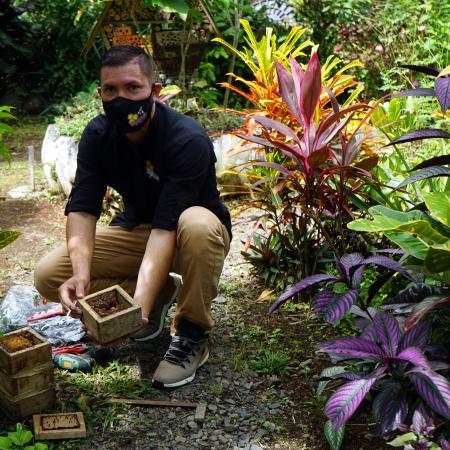
The districts of San Lorenzo, La Tigra, and Peñas Blancas are crossed by national Route 702, a route highly frequented for its final destination: the Arenal Volcano and La Fortuna, one of the most developed tourist centers in Costa Rica. However, the districts on Route 702, harbor immense tourist potential, great biodiversity, and tourist attractions of great interest. Likewise, there is a group of businesspeople and tourism entrepreneurs who develop their activities along this national route in search of better family income and personal development.
Bosque La Tigra has identified the tourism potential of this area and has promoted the development of skills in the tourism sector. First, with the support of GIZ, 14 people from the communities have been trained as local tour guides and 15 people have improved their management skills to apply them in their businesses.
In the second stage, Bosque La Tigra has fostered the local organization for better management of the tourist destination. Currently, a group of 30 business people and tourism entrepreneurs are organized to make decisions at the level of a new tourist destination: Destino Ecoturístico Ruta 702, making strategic decisions to develop the destination under a common vision. They have also formed a community for the exchange of experiences of good tourism practices and advice and recommendations from their peers to apply in their businesses. The organization also encourages productive linkages between businesses.
According to José Miguel Herrera, president of the Route 702 Ecotourism Association, entrepreneur and beekeeper "We organized ourselves to move forward as tourism entrepreneurs, developing the potential of our beautiful districts and supporting each other. We are aware of the precious biodiversity of our tourist destination and we want to make the best use of it while using it sustainably and guaranteeing its conservation".

